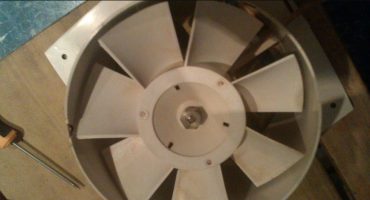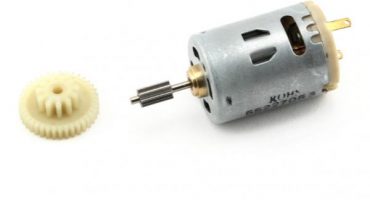The life of modern people is mostly held indoors. Eight hours at work and almost the rest of the time at home. It takes only an hour or two to get to the road. Moreover, the car should also be equated to the premises, including (and even more so) public transport and shops. Ventilation cannot do without air purification, although it is usually hidden from view. For this purpose, an exhaust fan with a non-return valve is most often used.

Check valve fan
Need for ventilation
If you do not change the air in the room with people, then the oxygen concentration decreases and it becomes difficult to breathe, and in the future, the threat to health and life itself grows. This is well known to submariners and those who worked in wells. In ordinary rooms, this is not so noticeable, primarily because they still have ventilation. In the simplest case, windows and doors open. In large houses, in addition there is passive exhaust ventilation in the form of a shaft facing the roof of the building. The air in it should move due to the temperature difference and the wind, which slightly increases traction.
However, such ventilation is almost never serviced, with time it becomes clogged with dust, kitchen burns, down of plants, insects and cobwebs. In addition, in winter, it can carry a significant amount of heat from the building. Previously, this was not given much importance, but in our energy-saving time it is important.
Poor ventilation leaves a lot of dampness in bathrooms. This leads to material losses: tiles, paint fall off, clothes do not dry well, mold may appear. Such a situation clearly does not add to people's health either. The risk of infections increases.

Ventilation shaft
Drive Fan Designs
Mechanical (paddle) fans appeared on ships to increase traction in boiler furnaces, and with the advent of electric motors, they immediately went into production and very soon appeared in everyday life. Forced ventilation very effectively solves the problem of gas exchange at low pressures. This case just refers to air at atmospheric pressure.
Fans are divided into two main types:
- radial (snails);
- axial.
The first type refers to powerful devices, the snail fan requires an engine with high torque. In the case of low power, such fans operate at low speeds and produce very little noise, but the disadvantage is their rather large size. Therefore, they are used to service a whole group of hoods, or as an input supply fan.

Radial (snail)
Axial fans are simpler, have small dimensions, and depending on the installation location they can be called ducted. Duct is made as an insert in the duct. Its task is to maintain the air pressure decaying in a long duct. especially because of the turns. The cause of the loss is the resistance of the walls of the air channels and the internal friction of the air on the bends of the ducts.
You should not think that the channel fan is always axial. It may well turn out to be of a snail type. Domestic duct fans are usually made axial, small in size for the diameters of standard ducts.

Duct fan
Check valve
The fan creates a directional movement of air in the duct pipe, helping natural draft, or sometimes working against it. No matter how it works, often there is a need to prevent the movement of air in the opposite direction. To do this, there is a device called a check valve. The non-return valve is designed to obstruct the movement of air in the opposite direction. In the forward direction, it opens by the force of air pressure, and when turned off, it closes and prevents the air from flowing in the opposite direction.

Gravity check valve
Such a valve can use several principles to return to its original state:
- gravity (example in the figure above);
- springs;
- bending resistance of the material (valve-membrane);
- power drive.
According to its kinematics and design, the valve can be made:
- semicircular petals (in the picture above);
- jalousie;
- rotary damper;
- movable damper (gate);
- flap diaphragm;
- obturator type (overlapping shutters).
Valves that can only be controlled by air pressure are petals, membranes, shutters, and counterweight butterfly valves. All others can only be with servos.
Household fans with check valve
In everyday life it is important to have comfort, people want to relax after work. One of the requirements for home fans is silent operation. This is especially true for fans for bathrooms and kitchens. In this case, all the noise remains in the room. To reduce noise, manufacturers use shock absorbers of various designs, balanced moving parts and ball bearings. The main source of noise is always the mechanical vibrations of the fan transmitted through the supports to the walls. Air vortices, which are always present during the operation of any blade fan, make much less noise. Silence is also achieved by the fact that the blades bend inward in the direction of flow. This, however, decreases and fan performance.
To reduce noise, you can use low power on the engine, but in this case, the air exchange coefficient is also reduced. The idea of using a duct fan equipped with sound-absorbing inserts also looks good. But it is not suitable for small apartments, where there is simply nowhere to put an air duct. In this case, you have to use axial. It is installed in a window, in a wall or in an exhaust vent of a building’s natural ventilation.

Axial for kitchen with check valve
The backpressure valve in such fans is equipped with petals-curtains of vertical arrangement. In this way a fan for the bathroom can be arranged, silent and with a non-return valve. The petals-curtains are returned to the reverse position by small springs, and are opened by air pressure when the fan is operating. This can be installed in the exhaust hood of home ventilation, in the window. For capital walls, more work will have to be done and the duct of the fan itself should be sufficient to pass through the wall. Axis for the kitchen with a check valve
It is much more difficult to install a household appliance in a double-glazed window. This can only be done if the glass is completely replaced with a specially made one. There are companies that provide such services.
Together with the fans, a recuperator can be used, this is a device for heat exchange between incoming and outgoing air. The incoming cold air is heated by the outgoing warm air with a developed surface heat exchanger. Condensate formed is discharged through a pipe. At the same time, heating costs are reduced to some extent. For ventilation it is necessary to overcome the greater resistance in this device. Such ventilation is more complicated in the device, and usually dispenses with a non-return valve, since the air does not bring cold with it and without the fan working, the recuperator hardly passes air.
Reversible and supply fans
Sometimes it is necessary not to drive the air out, but rather, to borrow it from the street. This need arises from the widespread use of plastic windows, which very tightly block the access of air from the street. Due to this, exhaust ventilation does not work well or almost does not work. Supply air can be filtered out from street dust, soot and debris of plant origin (pollen, fluff).
Like the exhaust, the supply air also often has a check valve. Air can be additionally heated in cold weather or ionized for disinfection. There is a good video on this subject:
There is a supply system without fans. Video on this topic:
Reversible has a motor that can rotate not only in one direction. Accordingly, it can work both as a supply and exhaust air, which makes it very versatile. (The cochlea cannot be used effectively as a reversible fan.) The reversibility property no longer allows the use of simple non-return valves in such fans. Instead, they use blinds with an electromechanical drive, which leads to a noticeable rise in price of the device.
The fan in the cooker hood, unless it is equipped with its own fan, it is advisable to purchase the channel type and insert it into the middle of the duct, which goes from the umbrella (hood) to the output device. It should also be understood that over time it will be thoroughly contaminated with soot and oil, which means that its design should make it easy to disassemble and clean it.
Installation and fan safety
In order for the device to reliably and properly perform its functions, it must be correctly installed and secured. For this purpose, together with the fan, a variety of holders, protective grilles, seals and fasteners are included in the sales kit. Consumers should carefully study the instructions before installation, if they are going to do it themselves, without resorting to specialists.
It is also worth remembering that a fan can become a source of a very strong cold, especially in the summer heat. You should not be directly in front of him for a long time and this must be taken into account when choosing a place for him.
Fan selection

Fan selection
Some models and their prices are listed in the table.
| Mark | Power, W. | Productivity, m3/ h | Noise, dBA. | Features | Cost |
Blauberg Aero still 100 | 5,5 | 83 | 25 | Low noise. | 1500 p. |
Cata E 100 G | 8 | 115 | 31 | Ball bearings | 2950 p. |
Cata E 100 GTH | 8 | 115 | 31 | Humidity sensor with digital indicator. Timer. | 6800 p. |
Soler & palau SILENT-100 CDZ | 8 | 95 | 23 | Silent, with motion sensor and remote control. | 6500 p. |
Vortice Vort Press Habitat LL 45/135 | 29 | 150 | 48 | Radial, splashproof. | 9300 p. |
When choosing a fan, one should take into account its purpose, price and performance. The last parameter, perhaps, is the most important. For rooms, air should change 2 times per hour, for a fan in the kitchen 4-5 times, and for a bathroom, where there is still a need to dry the room, due to the high partial pressure of water vapor, the air must be changed 10-15 times per hour. Everything else is simple: we calculate the volume of the room in cubic meters and divide the fan performance by the volume of the room. This will give the necessary multiplicity. For example, let a bathroom have dimensions of 3 x 3 x 2.5 m. The volume will be 22.5 m3. To fully ventilate the bathroom, you will need two fans from the last line in the table. which will give 13-fold air exchange per hour. But at least one such fan is acceptable, it just works for half an hour longer.
Fan noise will interfere in the house, in this case it is better to pay extra money for comfort. For a garage, on the contrary, noise has almost no significance; here you can choose the cheapest fan. For a bathroom, it is better to purchase a device for a voltage of 12 V, so it will be much safer.Additional functions, such as a timer or humidity sensor, are more suitable for greenhouses, incubators, they will not be of particular use at home, and in the Smart Home system any device is controlled by a controller, so the latter takes on all these functions.



